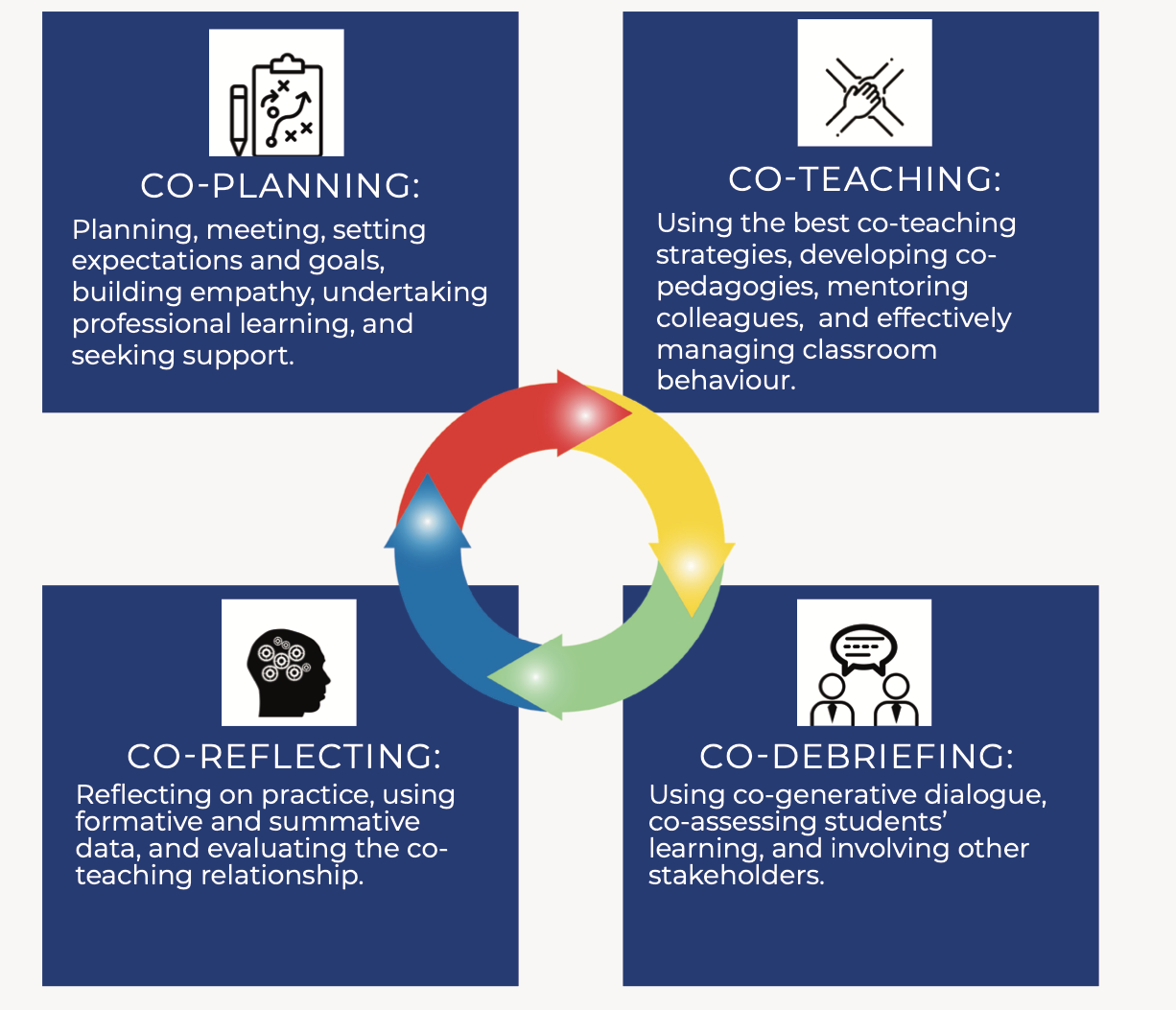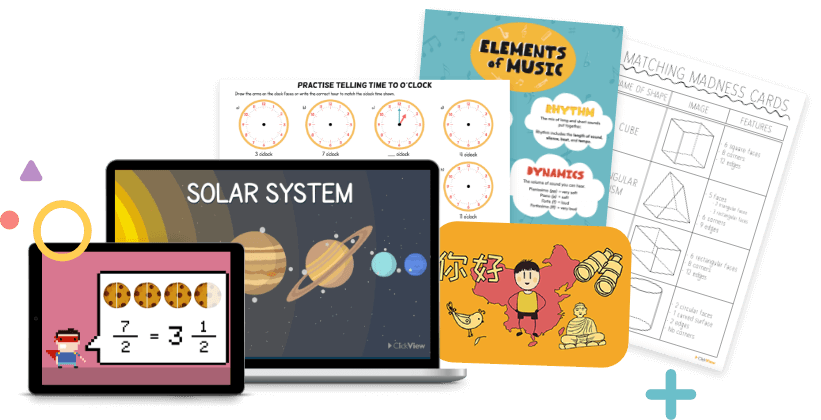ClickView’s guide to co-teaching and its benefits
What is co-teaching?
Co-teaching is when two (or more) teachers collaborate on the planning, delivery, and assessment of a lesson, classroom management, and organisation of the learning environment.
Part 3 of the DFE’s Standard for Teachers’ Professional Development states that professional development aiming to change a teacher’s practice is most effective when it includes collaboration. When teachers work together, they can challenge existing practices, better support students, and build-in peer support when problem-solving.
Restrictive teaching approaches segregate students with disabilities from the mainstream student population. Co-teaching stems from an inclusive education framework in which regular teachers work alongside special education teachers to teach children with diverse abilities and needs.
Students with special educational needs, learning disabilities, and other disabilities work beside their peers in regular classrooms. All students benefit from a greater sense of belonging, increased learning opportunities, higher expectations for achievement, greater collaboration, development of social relationships, and respect and understanding of diversity.
The benefits of co-teaching
| 1. Supporting inclusion and differentiation | 2. Holistic assessment and curriculum | 3. Professional development |
|
|
|
| 4. Teacher efficacy | 5. Learner and teacher wellbeing | 6. Positive pedagogical impact |
|
|
|
Creating an inclusive environment using co-teaching strategies provides better quality education for all students, encourages professional competence and co-operation with colleagues, and fosters a sense of respect in the school and broader community.
The co-teaching cycle
Lyn Sharratt and Michael Fullan developed the Co-Teaching Cycle to illustrate the continuous collaborative processes involved in a successful co-teaching practice. The cycle is intended for teachers to have a mirror to their practice and provides the structure they need to accelerate their professional development.
These processes are outlined in the graphic below:

“The co-teaching cycle is the most powerful way to improve teaching practice. . . It pushes professionals to make their practices transparent and public in order to become increasingly more skilled, reflective, and thoughtful.”
~ Sharratt & Fullan’s (2012) Co-Teaching Cycle
List of co-teaching strategies
Developing inclusive classrooms where students with diverse needs can benefit from the expertise of two educators can be facilitated by adopting the following popular co-teaching strategies.
- One teach, one assist
- One teach, one observe
- Station teaching
- Parallel teaching
- Alternative (Differentiated) teaching
- Team teaching
We’ve provided subject-specific examples of how they can be executed in the classroom, though each strategy can be easily adapted to any curriculum subject.
1. One teach, one assist
One teacher takes on the lead teaching role while the other assists the students and supports classroom management.
Maths
In a lesson on solving quadratic equations, the lead teacher demonstrates the factorisation method on the smartboard. The assisting teacher hands out materials, monitors student work, asks the lead teacher to clarify ideas or misconceptions about factorising, answers student questions on substituting X values, and helps address any behavioural issues.
2. One teach, one observe
One teacher takes on the lead teaching role while the other observes and collects pre-determined information about the class.
Science
SEN students are being integrated into the mainstream Chemistry class in a laboratory lesson. The lead teacher performs the traditional teaching role. At the same time, the other teacher takes notes about the accessibility of the classroom and apparatus used in experiments, social interactions between students (and social skills), behaviour, areas to target for intervention, and ability to achieve learning outcomes.

In collaboration, the teachers debrief and reflect on the lesson to inform their co-teaching strategies. Individualised support is put into place to help students integrate smoothly, become more independent, and be more productive enabling all learners to succeed in future lessons.
3. Station teaching
Co-teachers plan a set of independent activities to be completed by small groups at separate stations over a set time limit. Student groups rotate through each station during the lesson. Each teacher can move around the groups to provide direct instruction and support.
English
Students are deconstructing scenes from Hamlet. The first station creates storyboards; the second station explores themes; the third station looks at context; the fourth station interprets poetic devices in Shakespearean language. Teachers can monitor the groups more effectively and facilitate participation.
Student learning is supported by grouping students of mixed abilities and needs together to encourage scaffolded learning experiences with their peers.
With a reduced teacher-to-student ratio, learners constantly receive feedback from co-teachers during the activities, increasing levels of engagement and the potential for achievement.
Free video: Alliteration (Series, Poetic Devies):
Description:
Students will discover what alliteration is and the impacts of this figurative language device on poetry using the poem ‘Wise Wahoo’ by teacher Jon. They will also learn why the device is used in poetry and be invited to experiment with the device themselves using an object.
Free teaching resources, Poetic Devices – Alliteration:
Production Year: 2020
Audience: Key Stage 2
Subject: English
4. Parallel teaching
The class is divided in half, and each co-teacher teaches the same content to one-half of the students. Groups don’t rotate, and the lesson’s timing should ideally run parallel to the other group.
Physical education
Co-teachers have split their class in two by assessing student behaviour, strengths and weaknesses, disabilities, and learning needs before starting a practical lesson during their football unit. After the teachers model skills for dribbling, they can increase the instructional intensity when the students begin to practice. They have fewer students to work with and have helped mitigate behavioural problems by considering grouping. This increases participation and allows students more time to master this technique.
5. Alternative (Differentiated) teaching
This strategy involves a primary teacher teaching a large group of students while the other teacher teaches the smaller group specifically targeted material. Alternative teaching allows co-teachers to be flexible when performing assessment, pre-teaching content, supporting lower ability students, and creating more opportunities for high achieving students.
Reading
One teacher is reviewing adjectives and adverbs with the main group of students. The other teacher takes a few students at a time, aside for a short reading assessment. When they co-debrief after the lesson, they can readily identify students who need remediation, students suitable for enrichment studies, and alternative methods of teaching content to improve student performance overall.

6. Team teaching
Co-teachers break up components of the lesson and take turns teaching, fielding questions, giving feedback, and sharing other classroom responsibilities. Team teaching can stimulate creativity as you discuss each other’s teaching ideas. Team teaching is also effective when teaching large classes, helping to maintain the lesson’s pace and everyone’s energy levels.
Design and technology
Students are designing clothes during the Textiles unit of the curriculum. One co-teacher works through the theory on sustainable materials from the front of the classroom; the other moves around to ensure that students are on task and helps answer their questions.
When the theory component is complete, students move to sewing machines. The teacher who ran the theory now supports the students while the other teaches them practical skills and safety measures.
Finally, as we continue working towards inclusive schooling systems, it is important to acknowledge the challenges. The unique circumstances of each school will influence the chances of success when implementing these strategies. Schools require funding, training, infrastructure, and support, and teachers need the time, resources, and help in the classroom to ensure that all students have access to high-quality education. It is absolutely worth striving for, and we are here to support you and your exceptional children in creating safer, more stimulating, and more inclusive schools.




